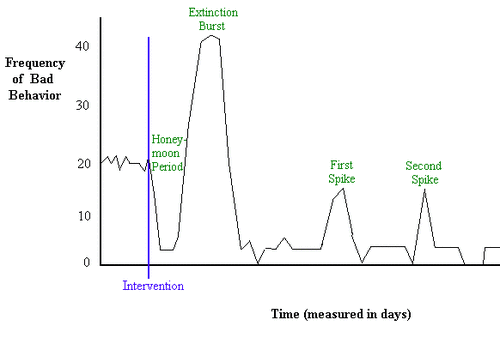Take a Before Measure
I have started with measurement on hundreds of difficult problems, both because it is essential to Participatory Action Research and because it brings so many insights.
Three Ways to Measure
- One can count the number of times it happens. For frequently occurring behaviors, such as screaming, one can select a portion of the day to count them and use that as a representative sample. For rarer behaviors, such as biting, one can count all day. For behaviors that occur only at certain times, such as throwing food on the floor, one can count only during mealtime.
- One can keep a record of the duration of the behavior where its length matters, such as crying on separation from mom. Again, when something is frequent, such as thumb-sucking, a sample time is sufficient. If I don’t know whether to time something or count it, I start measuring by duration, since the number of time segments also provides a count.
- Interval counts are a third way. A form is created that represents intervals of time, such as a minute or 15 minute intervals. If a behavior occurs in that particular interval is is counted as one, no matter how many times it occurs in that interval. One can count the number of 15 minute blocks of the day where someone sees a thumb go in the mouth.
Three Reasons to Measure
- It forces you to really see. It is difficult to describe how fully our expectations affect what we can see. Many times people think something is a problem and when they start to measure it they discover some aspect that they did not notice. Measuring makes you more attentive and wiser.
- It defines the boundaries of occurrence versus non-occurrence. For example, one child I knew bit other children, but he also simply mouthed them, too, without causing pain. It was difficult to tell when something was a slobbery lick or a hurting bite. Counting enabled me to tell the difference. Another child hit others, but sometimes he raised his fist in a threat to hit. What is a hit? The act of counting forces a clear definition of the action and an attention to the difference.
- It enhances communication. Here is the key reason. Usually when dealing with difficult behavior many people are involved, other staff, members of families, and administrators. It is much clearer to say Johnny hit 4 times yesterday and 2 times today than to say, “Well, it wasn’t so bad today.” Measurement brings the undeniable clarity of physical reality to each person involved. Facts are the basis for the co-construction of meaning that is the strength of this protocol.
 We need a way to keep records over time. We take the counts gathered a counter or tallies on a clipboard, and after a few days, we have enough to create a graph. As time goes by, we plot the points and connect the dots. To represent a change in circumstances, we draw a vertical line. The graph represents the physical reality over time.
We need a way to keep records over time. We take the counts gathered a counter or tallies on a clipboard, and after a few days, we have enough to create a graph. As time goes by, we plot the points and connect the dots. To represent a change in circumstances, we draw a vertical line. The graph represents the physical reality over time.
What it means, however, isn’t always clear. Discussing it helps make sense of it, which for those involved becomes another kind of reality, a socially-constructed reality. The graph gives us something we can all look at together in order to become smarter. That’s Participatory Action Research, and it sure beats reading a book.